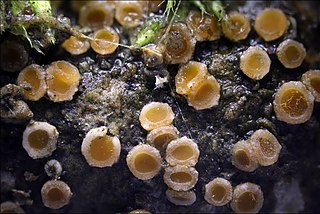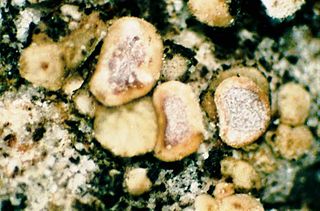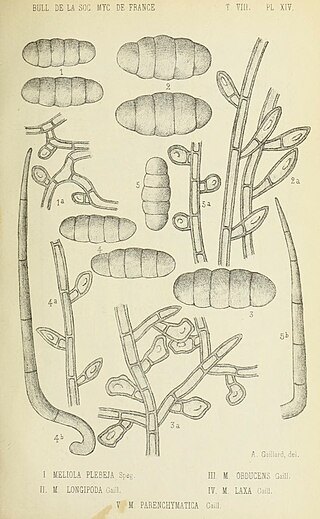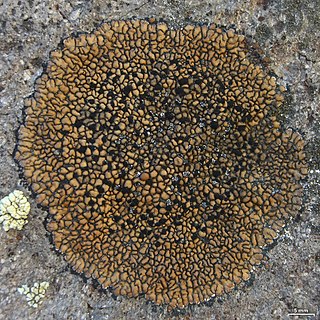
The Marasmiaceae are a family of fungi in the order Agaricales. Basidiocarps are most frequently agarics, but occasionally cyphelloid. According to a 2008 estimate, the family contained 54 genera and 1590 species, but molecular research, based on cladistic analysis of DNA sequences, has led to a more restricted family concept, so that the Marasmiaceae included just 13 genera, and some 1205 species. It was reduced further down in 2020, to 10 genera and about 700 species.

The Leotiomycetes are a class of ascomycete fungi. Many of them cause serious plant diseases.

The Pucciniaceae are a family of rust fungi that cause plant diseases, mainly on cereals such as wheat. The family contains over 4900 species: many of them in the type genus Puccinia.

Gyalectales is an order of lichen-forming fungi in the class Lecanoromycetes. It contains 5 families, 15 genera and about 550 species.

Pleosporaceae is a family of sac fungi. They are pathogenic to humans or saprobic on woody and dead herbaceous stems or leaves.

Diaporthales is an order of sac fungi.

The Dactylosporaceae or Sclerococcaceae are a family of lichen-forming fungi in the class Eurotiomycetes. It is the only family of the order Sclerococcales and subclass Sclerococcomycetidae.

The Acarosporales are an order of fungi in the class Lecanoromycetes. Phylogenetic analyses conducted using the sequences of both the protein-coding gene RPB2 as well as nuclear ribosomal genes place this order within the subclass Acarosporomycetidae.

The Gyalectaceae are a family of fungi in the order Gyalectales.
Rhizomucor is a genus of fungi in the family Lichtheimiaceae. The widespread genus contains six species. Rhizomucor parasiticus, the species originally selected as the type, is now considered synonymous with Rhizomucor pusillus.
Lignoscripta is a genus of lichenized fungi in the family Trapeliaceae. This is a monotypic genus, containing the single species Lignoscripta atroalba.
Amylora is a genus of lichenized fungi in the family Trapeliaceae. This is a monotypic genus, containing the single species Amylora cervinocuprea.
Squamella is a genus of lichenized fungi in the family Cladoniaceae. The genus is monotypic, containing the single species Squamella spumosa, which is found in Australia. Both the genus and species were described by Samuel Hammer in 2001.

The Microascales are an order of fungi in the class Sordariomycetes, subclass Hypocreomycetidae. This is a relatively small order of mostly saprobic fungi that live in soil, rotting vegetation and dung. Some species are plant pathogens, such as Ceratocystis fimbriata, transmitted by beetles to living trees and causing cacao wilt and many other economically important diseases. Species in the genus Pseudallescheria are pathogenic to humans The order was circumscribed in 1980. Wijayawardene et al. in 2020 added more families and genera to the order.

Meliola is a large genus of fungi in the family Meliolaceae. It was circumscribed by Swedish mycologist Elias Magnus Fries in 1825.

The Ophioparmaceae are a small family of lichen-forming fungi in the order Umbilicariales. The family was circumscribed in 1988 by lichenologists Roderick Westgarth Rogers and H. Thorsten Lumbsch.
The Cystobasidiomycetes are a class of fungi in the subdivision Pucciniomycotina of the Basidiomycota. Most species are known from their yeast states; hyphal states, when present, produce auricularioid basidia and are frequently parasites of other fungi. The class contains five orders as well as two families and one genus (Queiroziella) of uncertain disposition. An additional order, Cyphobasidiales, has been proposed to accommodate several lichenicolous species, but its separation from the Erythrobasidiales has not been demonstrated.
Xyleborus is a genus of lichen-forming fungi in the family Stereocaulaceae. It has two species. The genus was circumscribed in 2009 by Richard C. Harris and Douglas Ladd with Xyleborus sporodochifer assigned as the type species. A second species, X. sporodochifer, was added to the genus in 2015.

The Lecideales are an order of lichenized fungi in the class Lecanoromycetes. The order contains two families: the Lecideaceae, which contains 29 genera and about 260 species, and Lopadiaceae, which contains the single genus Lopadium of 10 species.
Hyaloraphidium is a genus of chytrid-like fungi. It is the only member of the family Hyaloraphidiaceae, order Hyaloraphidiales and class Hyaloraphidiomycetes in the division Monoblepharomycota.












